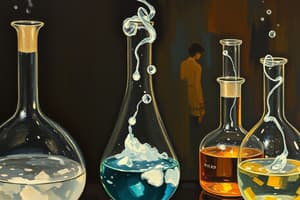Podcast
Questions and Answers
What is the main principle behind decantation?
What is the main principle behind decantation?
Difference in densities between liquids
Provide an example of decantation mentioned in the text.
Provide an example of decantation mentioned in the text.
Separation of oil and vinegar in salad dressing
How does chromatography separate compounds?
How does chromatography separate compounds?
Based on their interactions with a stationary phase and a mobile phase
Name two types of chromatography techniques mentioned in the text.
Name two types of chromatography techniques mentioned in the text.
What is the common principle shared by all types of chromatography?
What is the common principle shared by all types of chromatography?
What is the main principle behind the process of distillation?
What is the main principle behind the process of distillation?
How does evaporation differ from distillation?
How does evaporation differ from distillation?
What is the primary purpose of filtration in separation techniques?
What is the primary purpose of filtration in separation techniques?
Which separation technique is popular for isolating volatile compounds from non-volatile ones?
Which separation technique is popular for isolating volatile compounds from non-volatile ones?
How does decantation differ from filtration?
How does decantation differ from filtration?
Flashcards are hidden until you start studying
Study Notes
Separation Techniques in Chemistry
Chemists often face the challenge of isolating and purifying specific compounds from complex mixtures. This is where separation techniques come into play, allowing us to separate substances based on their unique properties. In this article, we'll explore several common methods, including decantation, chromatography, evaporation, filtration, and distillation.
Decantation
This simple yet effective method relies on the difference in densities between liquids. By pouring a mixture into a container, a heavier component will settle and remain at the bottom, while a lighter component stays at the top. By carefully pouring off the top layer containing the lighter substance, we can separate it from the remaining mixture.
A classic example of decantation is the separation of oil and vinegar in salad dressing. The oil, being less dense, remains above the vinegar, which is denser and settles at the bottom.
Chromatography
Chromatography is a versatile technique that separates compounds based on their interactions with a stationary phase and a mobile phase. Various types of chromatography exist, such as paper chromatography, thin-layer chromatography, gas chromatography, and liquid chromatography, but they all share a common principle: solutes move through a stationary phase at different rates due to their varying affinities for the stationary phase and the mobile phase.
Evaporation
Evaporation is a simple method that relies on the difference in volatilities between liquids. By heating a mixture, we can cause the more volatile component to vaporize and be collected using a condenser. This technique is popular for separating volatile compounds from non-volatile ones. For instance, we can separate water from ethanol by evaporation, as water has a lower boiling point and will vaporize first.
Filtration
Filtration is a process that involves the separation of solids from liquids or gases by passing the mixture through a filter medium. Solids are held back by the filter medium, while liquids and gases pass through. The choice of filter medium depends on the size of the solids to be removed, and filtration can be done using mechanical filters, membrane filters, or gravity filters.
Distillation
Distillation is a widely used technique for separating mixtures of liquids that have different boiling points. By heating a mixture, we create a vapor that is rich in the more volatile component(s). As the vapor cools and condenses, we collect it, separating it from the less volatile components in the mixture.
A classic example of distillation is the separation of water from ethanol. Water has a lower boiling point than ethanol, so it will vaporize first. After condensation, the collected vapor will be rich in water, and the remaining liquid will be enriched in ethanol.
Conclusion
These separation techniques are essential tools for chemists, allowing them to isolate and purify compounds from complex mixtures. The choice of the best method depends on the specific properties of the compounds involved and the desired level of purity. As chemists continue to develop new techniques and improve on existing ones, the future of separation science looks promising and holds immense potential for innovation.
Studying That Suits You
Use AI to generate personalized quizzes and flashcards to suit your learning preferences.


